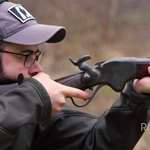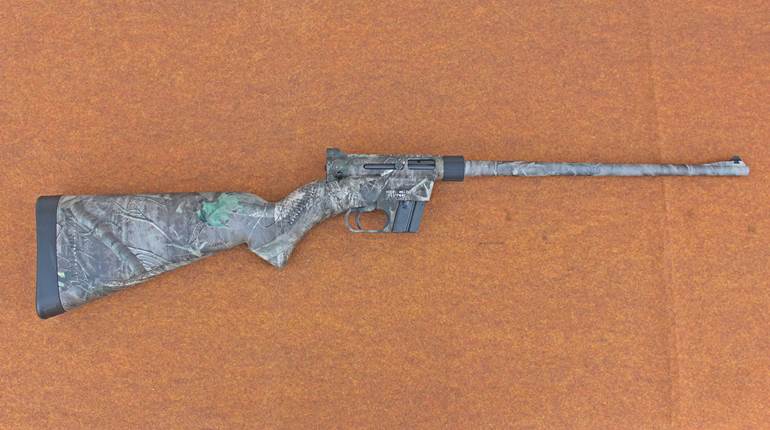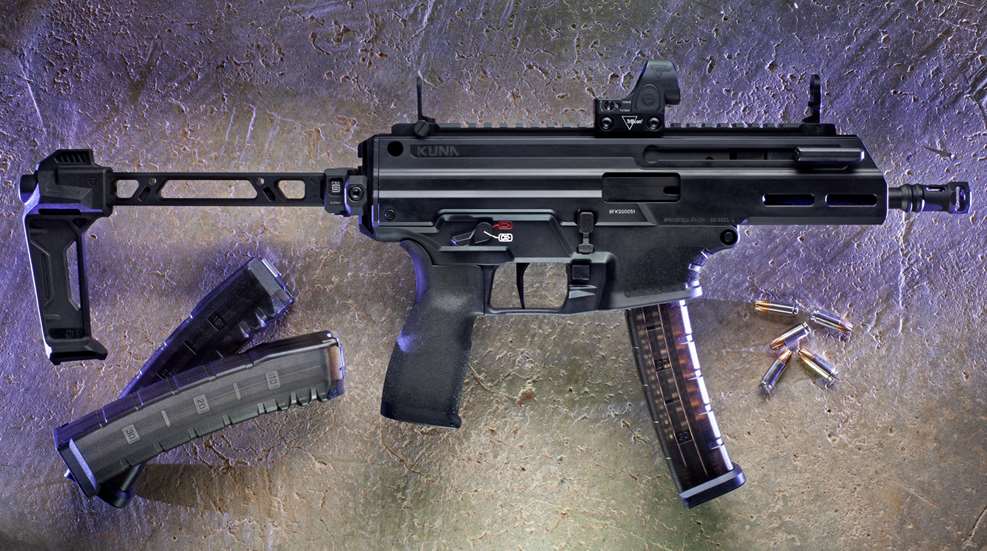
The partnership between Springfield Armory and Croatian manufacturer HS Produkt has brought many successful firearms to the U.S. market, from the original XD handguns and their successors, the Hellcat and Echelon, to the bullpup Hellion rifle. The latest result of this collaboration is the Kuna, a large-format, semi-automatic pistol, or as Springfield calls it, a “PDW” (personal defense weapon) “designed to deliver exceptional shooting stability in a portable package.” Isn’t every firearm a potential personal defense weapon for the armed citizen? Of course it is, but the Kuna has several features that are tailor-made for the role at a retail price that is right around the $1,000 mark.
The modern PDW concept goes back to the First World War. Back then, the military primarily had two classes of individual firearm—rifles and handguns. While the latter was hard to shoot accurately under stress, the former was heavy and clumsy to maneuver in the confines of a trench. Something was needed that was more effective than a handgun, but more compact and easier to carry than a rifle and with a greater ammunition capacity. Everything was tried, from pistols equipped with shoulder stocks and extended magazines to the Pedersen Device that converted the bolt-action Springfield rifle to fire a pistol cartridge semi-automatically. But the problem had not been satisfactorily solved by the war’s end.
Born of the Second World War, many consider the M1 carbine to be the first true PDW. At approximately 5 lbs., 4 ozs., unloaded, it was a light and handy firearm designed to be carried instead of a pistol by those other than frontline combat troops. In the increasingly mechanized post-nuclear world that followed, the military needed a compact arm to equip everyone from tank crews to helicopter pilots. Radical designs were proposed, from Colt’s Individual Multi-Purpose weapon “Arm Pistol” to the FN P90. The U.S. Army has recently revisited the PDW concept with its “Sub Compact Weapon” program, which chose a compact 9 mm Luger submachine gun as the Army’s next-generation PDW.
Is there an application for the PDW concept in the civilian world? I would argue that there is. In an environment of increasingly sophisticated threats to life and limb, a large-format pistol can give the well-trained and responsible citizen a fighting edge over a conventional handgun. Its advantages include better ballistics from a longer barrel (a 124-grain 9 mm Luger bullet has about 8 percent more velocity coming out of the Kuna’s 6" barrel versus the 4" barrel of the typical concealed-carry pistol), a longer sight radius, extra weight to mitigate recoil and allow for quicker follow-up shots, a higher ammunition capacity and a more reliable and robust action that is less sensitive to how the firearm is being held when it is fired. A large-format pistol also has the advantage that its legal status as a handgun allows it to be carried concealed, on the person or in a discreet carrying case, anywhere it is legal to carry a conventional handgun.
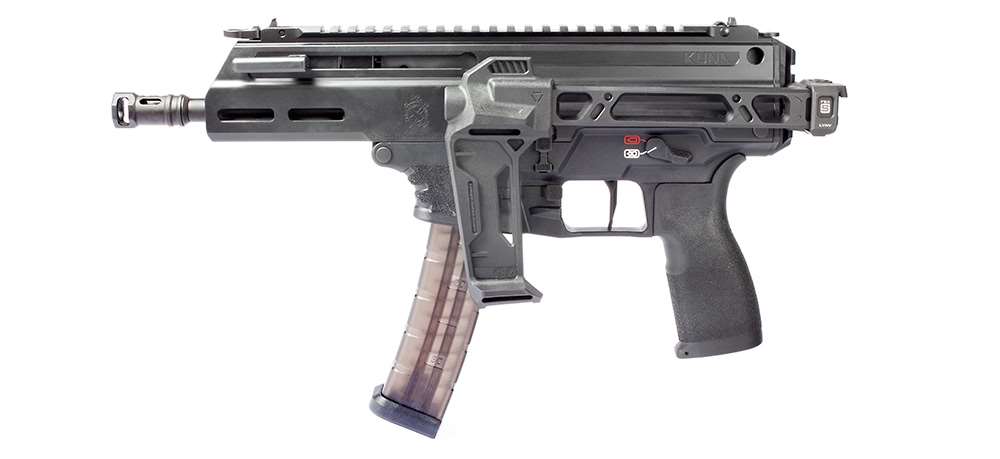
The Springfield Kuna (pronounced like “tuna”) checks all of these boxes. The name comes from the Croatian version of the pine marten, which is the national animal of that nation. Think “small but fierce”—precisely what a PDW should be. Like the Hellion rifle, the Kuna began its life as a military and law-enforcement product and went through the rigorous testing protocols that are required by those applications. The submachine gun version was launched at last year’s Brazilian COP international law-enforcement and security trade show. The initial order was for a Brazilian military police contract, with the guns chambered in .40 S&W. The semi-automatic-only pistol version covered here was designed exclusively for the U.S. market.
The Kuna uses a roller-delayed blowback action. Unlike the H&K system, which uses dual rollers that move in and out relative to the bore axis, the Kuna’s system employs a single roller that moves up and down. When the bolt is in battery, its upper extension overhangs the rear of the barrel, and the ends of the pin that secure the roller in place drop into two camming surfaces in the barrel trunnion. The extension also contains a counterweight (Springfield calls this part the “bolt lock”) that is held forward under spring pressure. When the pistol is fired, force pushes back on the bolt face. As the bolt begins to move rearward, the camming surfaces in the trunnion push the roller pin up, forcing the roller against a camming surface on the counterweight. This causes the weight to retract against spring pressure. The delay caused by having to overcome this resistance allows the pressure in the chamber to drop to a safe level before the cartridge case is extracted. Using this system eliminates the need for the heavy bolt and strong mainspring of a direct-blowback system. HS Produkt also claims a smoother-shooting, more accurate firearm with a longer service life. At 19.6 ozs., the Kuna bolt is heavier than those used by MP5-type firearms, but lighter than most direct-blowback bolts.
The Kuna’s monolithic upper, its serialized receiver and its handguard, are machined from 7075-T6 aluminum and given a black Type III hardcoat anodized finish. The fixed ejector and feed ramp are bolted-in steel components for greater durability. An M1913 Picatinny rail runs the receiver’s length, and the handguard has M-Lok slots at the 3-, 6- and 9-o’clock positions for attaching accessories. Push-button swivel sockets are on both sides of the rear of the receiver, and the receiver endplate has a section of M1913 Picatinny rail. Springfield offers a model of the Kuna with the Strike Industries FSA stabilizing brace, which uses a steel hinge, folding to the left side of the pistol, and has a push-button swivel socket at the rear. The brace can be configured to fold to the right, but the gun cannot be fired repeatedly in that position, as the ejection port is covered. It adds about 11 ozs. to the pistol’s overall weight, a mere 0.75" extra in overall length when folded and $150 to the MSRP.
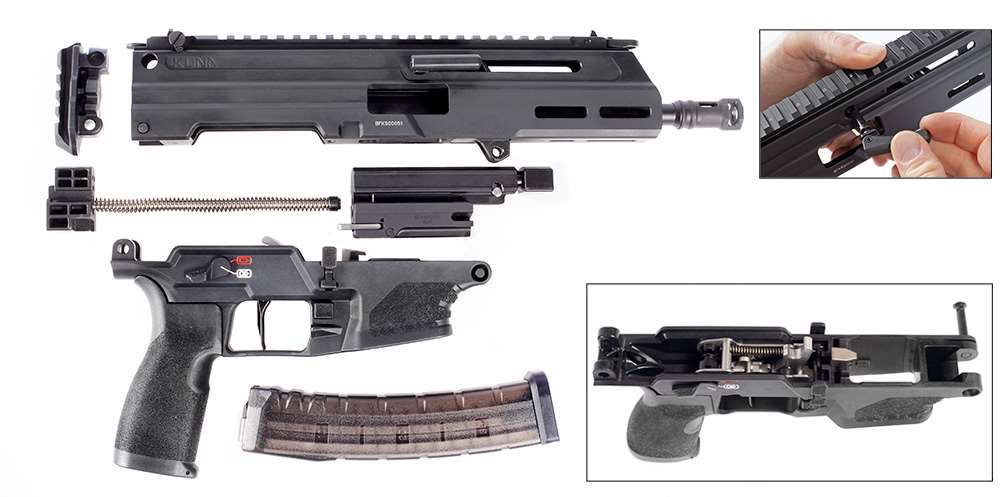
The trigger housing or “lower receiver” is made of reinforced polymer. Within it, the fire controls are contained in a stainless-steel chassis that can be removed as a unit. The pistol grip is a separate component that is compatible with AR-15 designs. The supplied grip has an internal storage compartment and uses the “Adaptive Grip Texture” found on Springfield’s Prodigy, Echelon and Hellcat pistols. This texturing, along with coarser “ribs” is also found on the magazine well, providing a second gripping surface for the large pistol.
The Kuna has bilateral controls for full ambidextrous use that will be familiar to an AR-15 user. A button-type magazine release is positioned on both sides of the lower housing. Generous flare to the magazine well allows for quick reloads, and the drop-free magazines do not need to be manually removed from the gun before another is inserted. The bolt locks open on an empty magazine, and a bolt release is present on both sides of the pistol. A safety lever is located above the pistol grip and moves 45 degrees between the Safe and Fire positions, which are clearly marked with “bullet/no bullet” pictograms. Contact surfaces on all three controls are given the same “adaptive” texturing. The non-reciprocating, forward-mounted charging handle is reversible (it is easily swapped from side to side when the pistol is disassembled) and folds under spring tension when not in use.
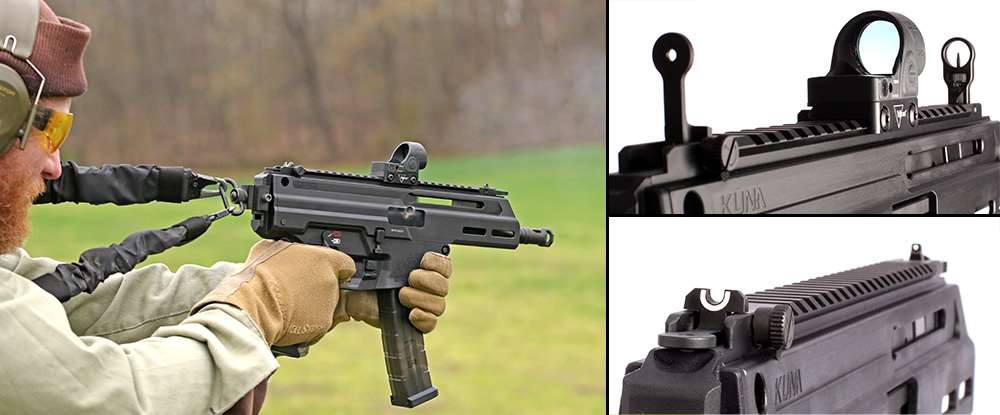
Does it take Glock magazines? No. While conventional pistol magazine compatibility is convenient, purpose-built, large-format-pistol magazines have their advantages. For the 9 mm Luger cartridge, the Kuna magazine is curved, meaning it has a shorter height than a conventional straight handgun magazine of the same capacity. Instead of the double-column-into-single-column feed of most handgun magazines, it is a double-column, staggered-feed design, meaning that it is more reliable and easier to load to full capacity by hand. Its design, where the rear of the follower activates the bolt hold-open, is less complicated and more robust than adapting a bolt hold-open device to a conventional pistol magazine with its front actuation point.
Kuna magazines, while proprietary, have an MSRP of $25. They are made of a translucent polymer, have metal-reinforced feed lips and a capacity of 30 rounds while weighing a mere 4.2 ozs. unloaded. A ribbed gripping texture is molded into their external surface, and they insert straight into the pistol’s magazine well. Two are supplied with each Kuna. Hopefully, Springfield will release 20- and 10-round magazines to allow for more compact carry and to allow for sales in regulated areas.
The Kuna’s built-in “hybrid” flip-up iron sights illustrate how well-thought-out the design is. When locked in their downward position, they present a fixed, highlighted, U-notch rear and front post with a white dot, much like the pattern found on Springfield’s Hellcat and Echelon pistols. This makes for an always-ready, low-profile sighting system, in the spirit of deep-concealment PDWs such as the H&K MP5KA1 with its minimal sights or the MP7. When the sights are flipped up, they display an aperture rear with click adjustments for windage and a hooded front post adjustable for elevation, similar to, but simpler than, those used on the Hellion rifle. Both provide an ideal sight picture when the Kuna is held at a handgun-length eye relief. I tested the Kuna with a Trijicon SRO red-dot sight mounted on Trijicon’s RM33 low Picatinny rail mount, and the iron sights co-witnessed perfectly with the optic when in the deployed position.

The Kuna’s 6" barrel is cold-hammer-forged and has a Melonite nitriding surface treatment, as do the pistol’s other steel parts. Its muzzle is threaded 1/2x28 TPI, and a multi-port muzzle brake is factory-installed. Although I did not test it, Springfield states that the Kuna’s action has been tuned to function suppressed. The firearm’s overall dimensions are in the spirit of classic compact 9 mm submachine guns—such as the B&T APC9K or the H&K MP5K—with an overall length of 15.5" and a weight of 4 lbs., 10 ozs., without the brace.
On the range, the Kuna’s accuracy is aided by its superb, possibly best-in-class, trigger. A two-stage design, the flat-faced aluminum trigger pulls through the first stage to hit a definite wall before breaking cleanly at just over 5 lbs. The reset is short and positive. All controls operate easily and intuitively, although it would be nice for the Kuna to have the dual charging handles of its military sibling. The safety can be activated while the hammer is uncocked, meaning the Kuna can be loaded and unloaded with the safety on.
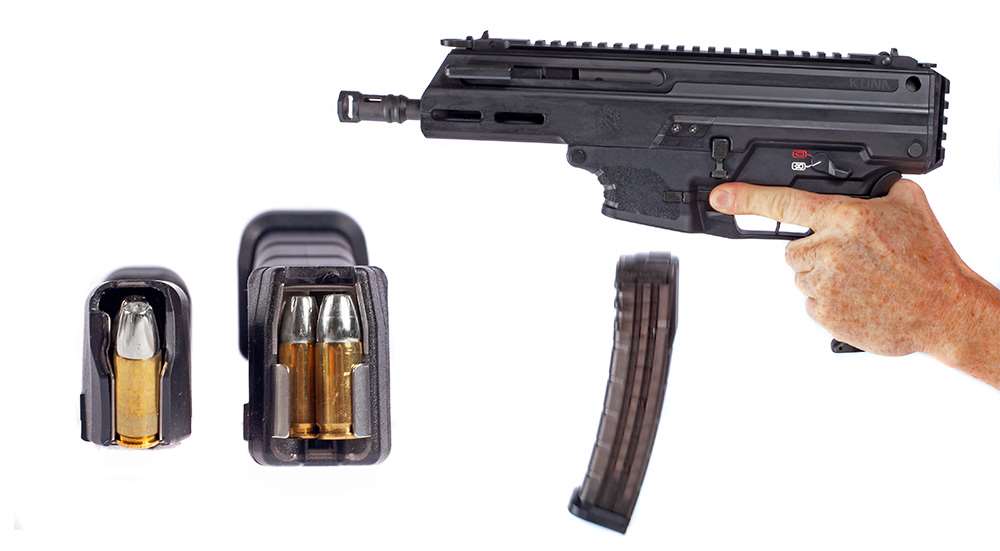
Roller-delayed blowback firearms are renowned for the “smoothness” of their recoil impulse. The Kuna’s recoil falls somewhere between that of a simple blowback system and an MP5-style firearm. A combination of the pistol’s size and the excellent trigger resulted in five-shot groups under 2" from a supported shooting position at 25 yards during my formal accuracy testing. In the folded position, the Kuna’s fixed sights shot to their point of aim at 25 yards, and the flipped-up aperture was easily regulated.
As the law prohibits a forward vertical grip on a pistol, the textured magazine well makes for the perfect support-hand placement point, helping to stabilize the pistol while keeping the fingers a comfortable distance from the muzzle. While the brace helps in stabilizing the Kuna, I found that a “bungee”-type sling, attached to the rear of the receiver to allow the pistol to be pushed out against its tension, was also an effective way to stay on target.
Although not stated explicitly in the owner’s manual, Springfield confirmed that the Kuna is rated for shooting +P ammunition, so I tested it with Winchester NATO-spec M1152 cartridges with their +P velocity. In addition to a wide range of velocities, the Kuna fed a variety of bullet shapes and weights.
The pistol’s disassembly procedures are simple, as would be expected, given the Kuna’s military/law-enforcement pedigree. After you have removed the magazine and confirmed the pistol is unloaded, push the rear captured disassembly pin in the lower housing to the right, which allows the assembly to hinge down. The front pin can then be released, allowing the lower to be removed from the upper receiver. With the lower removed, the endplate can be unlatched and slid out of the receiver. Pulling the charging handle to the rear allows the bolt and recoil spring assembly to be removed from the receiver. This is as far as Springfield recommends disassembling for cleaning.

The Kuna was developed around the .40 S&W, so there is enough strength built into the design to handle more powerful cartridges than the 9 mm Luger. And HS Produkt has suggested 10 mm Auto and .45 ACP versions may be on the way, though Springfield won’t confirm that.
As a self-defense firearm, “large-format” pistols offer additional ammunition capacity, more real estate for attaching accessories and a larger, more comfortable platform that makes it easier to deliver accurate shots. Modular in construction, ambidextrous in operation and optics-ready, the Kuna pistol in 9 mm Luger is a well-executed design and an affordable PDW for those seeking to optimize personal defense with a tool that stacks the deck in favor of the prepared.




















